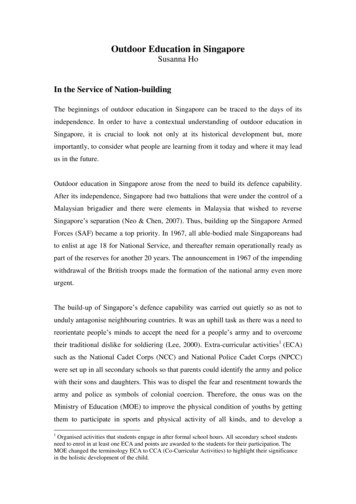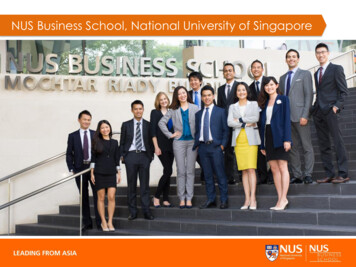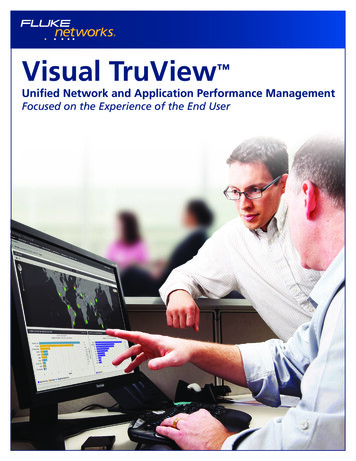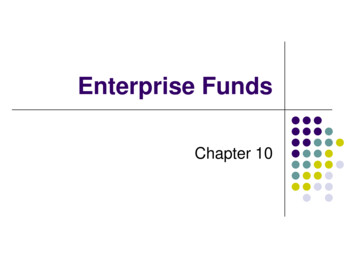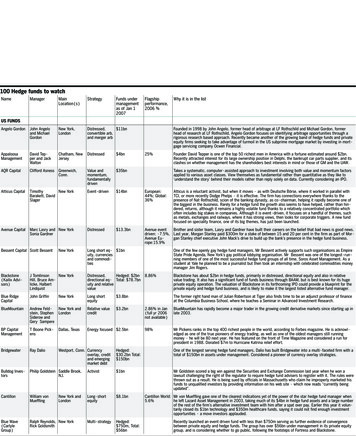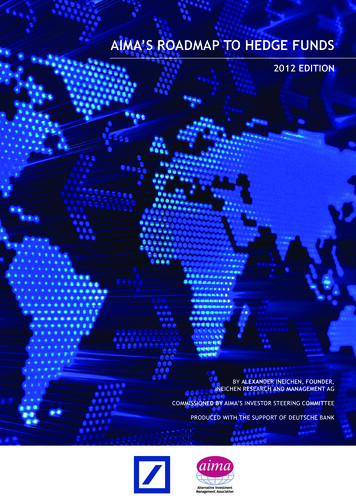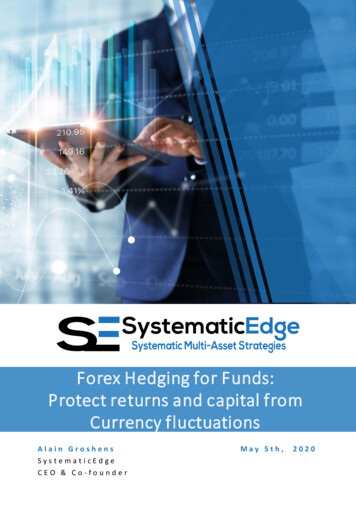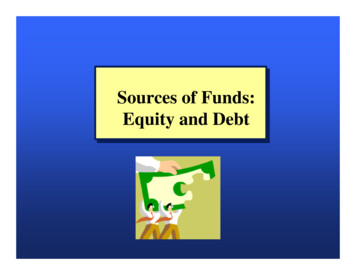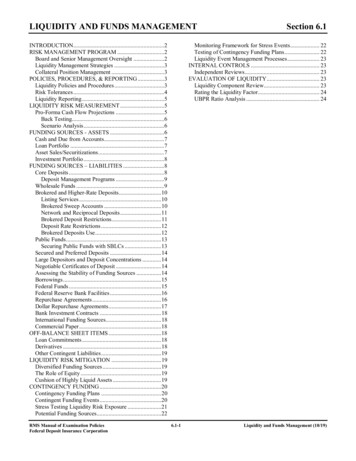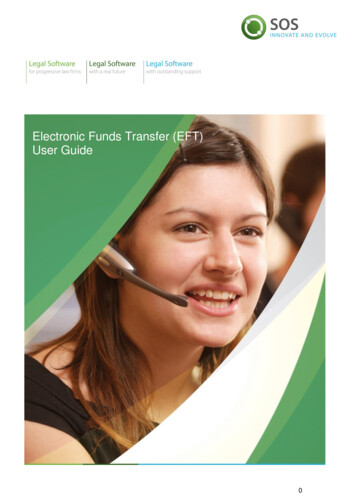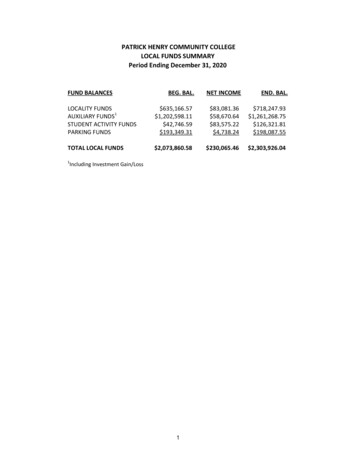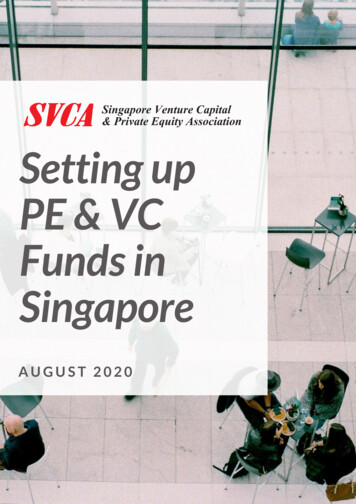
Transcription
Setting upPE & VCFunds inSingaporeAUGUST 2020
ContentsIntroduction . 2Regulation and Licensing . 3Licensing and registration of fund managers3Prospectus registration requirement5Licensing requirement for marketing of a closed-end fund5Fund Structures. 6Tax Considerations . 11Key Service Providers . 13Documentation . 14Some Key Terms . 15
IntroductionPE & VC funds are typically closed-end funds. Closed-end funds are pooled investmentvehicles that generally invest in the following asset classes: private equityreal estatenatural resourcesinfrastructuremezzaninedebt venture capitalcreditdistressed assetsfund of fundssecondariesagricultureClosed-end funds are funds where investors will (primarily or exclusively) not be allowed toredeem or withdraw from the fund at will. Investors will typically only receive a return on theirinvestment after the end of the fund term (usually five to ten years) or in circumstanceswhere any underlying investments are realised, through distributions by the fund.Investments made by closed-end funds tend to be illiquid with no readily available market forsuch assets and the investments are generally made with a view to only profiting in the longterm.Closed-end funds are usually marketed to and invested into by institutional investors or highnet worth individuals. At the initial stage, investors are only required to “commit” a sum forinvestment. The sum is only drawn down when a capital call is made during the investmentterm of the fund.
Regulation and LicensingLicensing and registration of fund managersManagers of closed-end funds in Singapore are typically incorporated as Singapore privatelimited companies and will be required to be licensed as a capital markets services licenceholder for fund management, registered as a registered fund management company orexempted under one of the licensing exemptions available under the Securities and FuturesAct, Chapter 289 of Singapore (“SFA”) in order to be able to conduct the business of fundmanagement.“Fund Management” is defined under the SFA to mean managing the property of, oroperating, a collective investment scheme, or undertaking on behalf of a customer (whetheron a discretionary authority granted by the customer or otherwise):the management of a portfolio of Capital Markets Products 1; orthe entry into spot foreign exchange contracts for the purpose of managing thecustomer’s funds,but does not include real estate investment trust management.(a)(b)The general categories of Fund Management Companies (“FMCs”) in Singapore are:(a)(b)licensed fund management companies (“LFMCs”); andregistered fund management companies (“RFMCs”).LFMCs are subdivided into three categories, namely:(a)LFMCs carrying on business in respect of all types of investors including retailinvestors (“Retail LFMCs”);(b)LFMCs generally restricted to carrying on business in respect of “qualified investors” 2only (“A/I LFMCs”); and(c)LFMCs who only manage Venture Capital Funds 3 (“VC LFMCs”).1“Capital Market Products” are generally defined in the SFA as securities, units in a collective investment scheme, derivativescontracts, spot foreign exchange contracts for the purposes of leveraged FX trading and such other products as the MAS mayprescribe (see section 2 of the SFA for further details).2“Qualified investors” include:(a)(b)(c)(d)3an accredited investor (as defined under the SFA);an institutional investor (as defined under the SFA), other than a collective investment schemea collective investment scheme or closed-end fund, the units of which are the subject of an offer or invitation forsubscription or purchase made only to accredited investors (as defined under the SFA), or investors in an equivalentclass under the laws of the country or territory in which the offer or invitation is made, or institutional investors (asdefined under the SFA), or both; anda limited partnership, where the limited partners comprise solely of accredited investors (as defined under the SFA)or investors in an equivalent class under the laws of the country or territory in which the partnership is formed, orinstitutional investors (as defined under the SFA), or both.“Venture Capital Funds" are funds that:(a)(b)(c)(d)invest at least 80% of committed capital in securities that are directly issued by unlisted business ventures that haveeach been incorporated for no more than 10 years at the time of initial investment;invest up to 20% of committed capital in other unlisted business ventures that do not meet the requirements in item(a) above (i.e. they have each been incorporated for more than 10 years at the time of the initial investment, and/orthe investment is made through acquisitions from other investors in the secondary market);must not be continuously available for subscription, and must not be redeemable at the discretion of the investor; andare offered to accredited investors and/or institutional investors (each as defined under the SFA).
As Retail LFMCs are subject to more onerous licensing and conduct of businessrequirements, managers of PE and VC funds often seek to operate as either A/I LFMCs orRFMCs (depending on the total AUM expected to be managed), given that these funds aretypically only offered to sophisticated and high net worth investors.Alternatively, where the funds qualify as Venture Capital Funds, managers may opt to belicensed as a VC LFMC. VC LFMCs generally undergo a simplified and shorter licensingprocess, and are subject to fewer capital requirements and conduct of businessrequirements which A/I LFMCs and RFMCs are subject to.The key requirements and restrictions applicable to A/I LFMCs, VC LFMCs and RFMCs areset out below.Type of ManagerInvestor ClassRestrictionNumber of ClientsA/I LFMCVC LFMCRFMCAccredited Investors andInstitutional InvestorsAccredited Investors andInstitutional InvestorsAccredited Investors andInstitutional InvestorsNo restrictionNo restriction30 clients (of which amaximum of 15 may befunds or limitedpartnerships)Assets underManagementRestrictionBase CapitalRequirementRisk BasedCapitalRequirementNo restrictionNo restrictionNo more thanS 250,000,000S 250,000NoneS 250,000Financial resources are atleast 120% of theoperational riskrequirement 4NoneNoneCEOCEO should have at least5 years of relevantexperienceNo minimum experiencerequiredCEO should have at least5 years of relevantexperienceDirectors 5At least 2 directors with 5years of relevantexperienceAt least 2 directors - nominimum experiencerequiredAt least 2 directors with 5years of relevantexperienceAt least 1 director shall beresident in SingaporeAt least 1 director shall beresident in SingaporeAt least 1 director shall beresident in SingaporeRelevantProfessionals5Representatives5At least 2 with 5 years ofrelevant experienceAt least 2 - no minimumexperience requiredAt least 2 with 5 years ofrelevant experienceAt least 2 resident inSingaporeAt least 2 resident inSingaporeAt least 2 resident portingNot requiredNot requiredNot requiredAnnual, Quarterly and AdhocAnnual and Ad-hocAnnual and Ad-hoc4Please see the Securities and Futures (Financial and Margin Requirements) Regulations, Securities and Futures and NoticeNo. SFA 04-N13 on Risk Based Capital Adequacy Requirements for Holders of Capital Markets Services Licences.5An individual meeting the relevant requirements can ‘double-hat’ or ‘triple-hat’ and simultaneously fulfil the requirements for adirector, relevant professional and/or representative.
Prospectus registration requirementGenerally, a SFA-compliant prospectus is required to be registered with the MonetaryAuthority of Singapore (“MAS“) for offers of capital markets products (such as interests in afund) to persons in Singapore unless the offer is one which is specifically exempted from theprospectus registration requirements under the SFA.The following are the prospectus registration exemptions which are commonly relied upon:(a)(b)(c)“50-offerees” private placement exemption (“Section 302C Exemption”);exemption for offers made only to institutional investors (as defined under the SFA)(“Section 304 Exemption”); andexemption for offers made to accredited investors and certain other relevant persons(as defined under the SFA) pursuant to Section 305 of the SFA (“Section 305Exemption”).Briefly, the Section 302C Exemption and the Section 304 Exemption are self-invokingexemptions. The Section 302C Exemption can be relied upon provided that offers are notmade to more than 50 persons in any 12-month period (subject to certain rules onaggregation).Because of the restriction in the number of offers and the limited category of investors towhich an offer can be made under the Section 302C Exemption and the Section 304Exemption respectively, some managers choose instead to invoke the Section 305Exemption which is generally available for closed-end funds constituted on or after 1 July2013. Invoking this prospectus registration exemption will require a notification to the MASvia its online CISNet platform. Certain information on the fund will need to be providedduring the notification process, including the structure of the fund, the type of fund, size ofthe fund, amount of funds offered in Singapore, information on the manager, the director ofthe responsible person, and custodian of the fund. The information memorandum of the fundwill also be required to be submitted to the MAS for its records. There are also certainprescribed disclosures set out under the Sixth Schedule to the Securities and Futures(Offers of Investments) (Collective Investment Schemes) Regulations 2005 that will need tobe included in the information memorandum of the fund, either directly in the body of theinformation memorandum, or by way of a Singapore ‘wrapper’.Licensing requirement for marketing of a closed-end fundThe marketing of any collective investment scheme to persons in Singapore is regulated asdealing in capital markets products in respect of a collective investment scheme under theSFA. The marketing of a collective investment scheme will have to be effected through:(a)(b)a holder of a capital markets services licence for dealing in capital markets productsthat are collective investment schemes; ora person who is exempt from such licensing requirements under the SFA.LFMCs (including for the avoidance of doubt A/I LFMCs and VC LFMCs) and RFMCs areexempt from the licensing requirement to the extent that they only market collectiveinvestment schemes that are managed by themselves or by their related corporations.
Fund StructuresClosed-end funds domiciled onshore in Singapore are usually structured as companiesincorporated under the Companies Act, Chapter 50 of Singapore, or Singapore limitedpartnerships formed under the Limited Partnerships Act, Chapter 163B of Singapore.Closed-end funds may also take the form of Variable Capital Companies (“VCCs”)established under the Variable Capital Companies Act (No. 44 of 2018) of Singapore (the“VCC Act”).Funds managed or advised by a manager in Singapore can also comprise offshore legalvehicles, and many are composed of a combination of offshore and onshore vehicles. Thesefunds may also take the form of master-feeder structures: A feeder fund is an investmentpooling vehicle into which investors would invest their moneys. The feeder fund would investall or substantially all its assets into a master fund, the investment holding company thatwould make the investments.Some typical fund structures are:1.Limited PartnershipOnshore funds may be structured as Singapore limited partnerships under the LimitedPartnerships Act, Chapter 163B of Singapore. In the Cayman Islands, funds may bestructured as exempt limited partnerships.Limited partnerships operate with two or more partners – general partner(s) and limitedpartner(s). The general partner will typically be involved in the day-to-day operations of the
limited partnership, while limited partners are typically prohibited from engaging in themanagement of the limited partnership. The general partner is subject to unlimited liabilityfor the debts, obligations and liabilities of the limited partnership, whereas limited partnersare normally only liable to the extent of their respective capital commitments.Limited partnerships are often a preferred choice for closed-end funds.Investors would make a capital commitment and contribute their pro rata share of capitalcontributions upon a capital call.2.Standalone CompanySome onshore funds are structured as private or public limited companies, which areincorporated in Singapore under the Companies Act, Chapter 50 of Singapore or as VCCs(if the VCC is constituted as a non-umbrella VCC). In the Cayman Islands, corporate fundsare incorporated as Cayman Islands exempt companies.The company exists as a separate legal entity from its members, and as such is able toacquire assets under its name. Each shareholder will be liable for the unpaid sum on theirshares.Investors would typically make a capital commitment and contribute their pro rata share ofcapital contributions upon a capital call. Shares of the fund will be issued to each investorpursuant to their capital contributions. The fund will be managed by the fund managerappointed by the company.
3.Umbrella CompaniesCorporate Fund(Umbrella Company)Sub-fund 1Sub-fund 2Certain jurisdictions offer corporate forms that can be constituted with an umbrella structure.In the Cayman Islands, segregated portfolio companies (“SPCs”) may create segregatedportfolios and in Singapore, VCCs (if the VCC is constituted
“Venture Capital Funds" are funds that: (a) invest at least 80% of committed capital in securities that are directly issued by unlisted business ventures that have each been incorporated for no more than 10 years at the time of initial investment; (b) invest up to 20% of committed capital in other unlisted business ventures that do not meet the requirements in item (a) above (i.e. they have .
